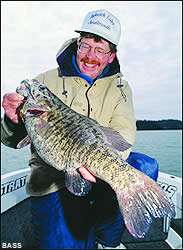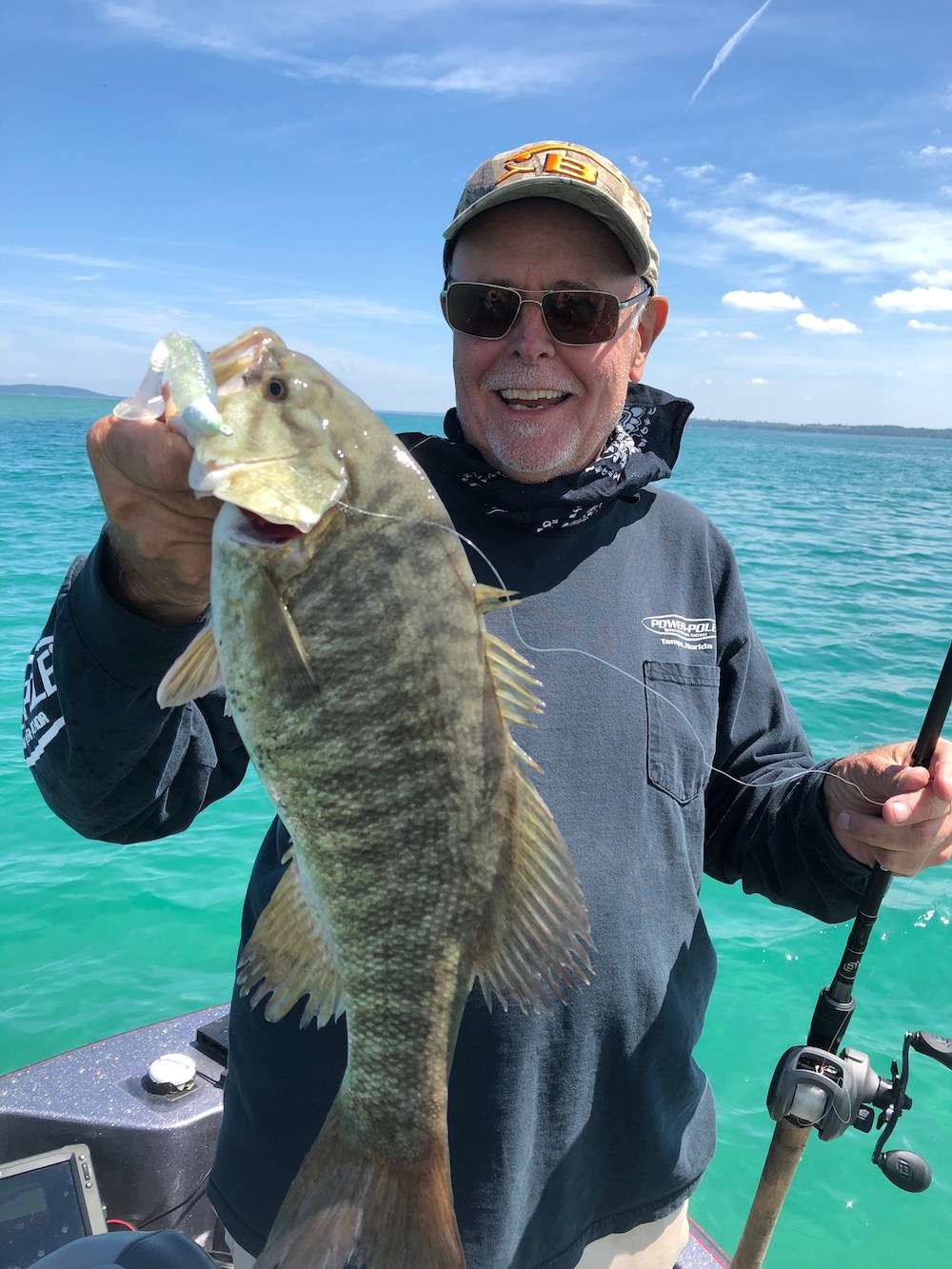
Many bass anglers agree that smallmouth represent our sport’s greatest challenge — their propensity for deep water and offshore structure makes these fighters notoriously hard to find and catch. It’s during the spawning season, when smallies move shallower, that we Bassmasters have a shot at the biggest bronzebacks of the year.
Yet even during this time, they can be maddeningly tough to pattern. Bassmaster queried two legendary guides for some input on spawning smallies. Fred McClintock (931-243-2142; www.trophyguideservice.com) guides on Dale Hollow Lake, a highland reservoir on the Tennessee/Kentucky border that produced the world record smallmouth. Steve Hacker (256-760-8090; info@smallmouth.com) is a veteran bronzeback guide on Pickwick Lake, Ala., a river-run reservoir known for big smallmouth. If you’re hankering to hang into a giant brown fish this spring, what follows can provide you with the input you’ll need to succeed.
BASSMASTER: At what water temperature do you find smallmouth beginning to move into their spawning areas?
McCLINTOCK: The first ones make their move when the water hits the mid- to upper 50s. This is a good time to catch a giant fish at Dale Hollow – I’m convinced the biggest ones move in first to find the choicest spawning areas.
HACKER: The 53 to 55 degree range is magic for big prespawn fish at Pickwick.
BASSMASTER: Do smallmouth “stage” or hold for a period of time in deeper water adjacent to spawning areas the way largemouth do? And, are staging smallies catchable?
McCLINTOCK: The initial move they make out of deep channel structure, where they spend the winter, is to a ledge or sharp dropoff close to a potential spawning spot. They’ll hold there 20 to 30 feet deep and wait for conditions to get right before moving up to spawn. Staging fish are most catchable when the wind is howling — they’ll move shallower and slam suspending jerkbaits, crankbaits and spinnerbaits. On calm days, they’ll sit on the bottom around a solitary stump or rock; you’ll have to slow roll a big willowleaf spinnerbait or bump a jig to catch ’em.
HACKER: Staging smallies will bunch up in big numbers downstream of a spawning area in places where the lake narrows down. I’ve had many days on these neck-down spots when our biggest five weighed over 30 pounds, sometimes with multiple 7-pounders. A compact leadhead bait like a tube, bucktail or Sassy Shad popped repeatedly off the bottom will whack ’em.
BASSMASTER: Where, and how deep, do smallmouth spawn?
McCLINTOCK: Smallies will use flats, humps and long points with pea gravel, fine shale and hard clay bottoms. Since Dale Hollow is normally clear, they spawn deep – 8 to 15 feet, down to 20 feet some years. If the lake is stained from unusually heavy rains, they may spawn much shallower, 3 to 5 feet, but this is rare.
HACKER: A biologist who works Pickwick told me that smallmouth, as a species, don’t require as much sunlight to incubate their eggs as largemouth, which explains why they spawn down to 18 feet here, even though the water is murky. They rarely spawn shallower than 6 feet; I’m convinced the biggest fish spawn deepest.
BASSMASTER: At what water temp can you expect smallmouth to be spawning?
McCLINTOCK: Anywhere from 58 to 70 degrees, but I find they spawn more by moon phase than water temperature. I normally catch my biggest spring fish in spawning areas one or two days before the full moon in April.
HACKER: Many fish will be on beds here when the lake hits the low to mid-60s around the new or full moon, but I’ve caught smallmouth that were discharging fully developed eggs in 79 degree water. They aren’t as cold-natured as most fishermen think.
BASSMASTER: How do they relate to cover when spawning?
McCLINTOCK: Very loosely. They like a gravel flat or hump with a few scattered stumps or patchy weeds on it.
HACKER: Pickwick smallmouth often use cover as current breaks. They’ll make a bed right behind a rock or stump directly in the current’s path.
BASSMASTER: Can factors such as flooding or drought negatively impact the spawn?
McCLINTOCK: Smallmouth are much more susceptible to having their spawn trashed by bad weather and water problems than largemouth. For example, they won’t spawn in high, muddy water. If smallies are on bed and the lake has a sudden rise or fall, or if there’s a sharp air temperature drop, they may leave the nest and not return.
HACKER: Biologists have told me that as much as 40 percent of the mature smallmouth population won’t spawn at all in any given year, even when water and weather conditions seem ideal! To me, this speaks volumes about bag limits and catch-and-release — I feel these fish should all be released, even the big ones, and given maximum opportunity to spawn. Don’t kill a trophy-size smallmouth; there are excellent replica mounts available today.
BASSMASTER: In clear Northern waters, smallmouth are so susceptible to bed fishing that some states prohibit fishing during the spawn. It’s different in the mid-South, though, isn’t it?
McCLINTOCK: When they first move in, they’re aggressive and highly catchable — you can swim a grub past ’em and they’ll rip the rod out of your hands. But unlike largemouth, once they’re locked onto the nest, they become extremely difficult to catch. You’ll occasionally feel a fish pick up your bait and drop it, but you almost never catch it.
HACKER: Bedding smallmouth are definitely less aggressive than bedding largemouth. And since their beds are too deep to sight fish, there’s no such thing as provoking them into biting the way you can with largemouth. I’ve never even seen a smallmouth bed.
McCLINTOCK: I’ve seen a couple; they’re light-colored and about the size of a dinner plate, with gravel around the perimeter.
BASSMASTER: What lures and presentations work best for smallies around spawn time?
McCLINTOCK: When they first move onto the nest, my most dependable lure for numbers of fish is a 5-inch twist-tail grub on a 1/8-ounce jighead — smoke, white or some translucent color like blue or watermelon in clear water; chartreuse or red in stained water. For trophy-class smallies, I slow roll a white willowleaf spinnerbait in the 12- to 20-foot zone. Like I said earlier, they won’t bite much of anything when they’re actually spawning.
HACKER: When my prespawn baits quit working, I switch to crawling or “stitching” a brown-and-green straight-tail worm, Texas rigged with a 1/8-ounce sinker, across the bottom on 8-pound line.
BASSMASTER: How long do smallmouth typically stay on the bed?
McCLINTOCK: Best I can tell, the female leaves soon after laying her eggs and the male stays on the nest around 10 days to guard the eggs or fry. The reason I say 10 days is because that’s how long the fishing is usually bad! Once it picks back up, I figure they’ve left the nest.
HACKER: I don’t think they’re nearly as aggressive about guarding their fry as largemouth are. I think once they’ve spawned, they’re outta there.
BASSMASTER: Then where do they go?
McCLINTOCK: The females move to the first deep dropoff adjacent to their spawning grounds and suspend. Often they’ll be hanging 20 to 30 feet deep over 80 feet of water, like where the river channel intersects a big flat. Believe it or not, they’ll come to the surface to hit a Zara Spook or an A.C. Shiner floating minnow — you can actually see ’em rise out of the depths to grab it! I’ll also catch postspawn smallies around flooded bushes on main lake flats; these fish will strike a spinnerbait or soft jerkbait, especially on windy days.
HACKER: At Pickwick, many postspawn fish gravitate to offshore structure like rockpiles, humps and ledges to spend summer and fall. I catch these fish on leadhead baits, crankbaits, topwaters and Carolina rigged lizards.
BASSMASTER: Any final thoughts on fishing for spawn-time smallies?
McCLINTOCK: I believe bedding smallmouth often vacate the nest permanently when pressured. I also have a hard time believing you can put a spawning smallmouth in your livewell, then release it, and it’ll swim back to its nest. Thankfully they don’t all spawn at once, and Dale Hollow is so big, you can always find some prespawn and postspawn fish, so you don’t have to intentionally target spawners.
HACKER: Any smallmouth you suspect was caught off the bed should be released immediately so it can do what we Bassmasters need it to do: make more smallmouth!





